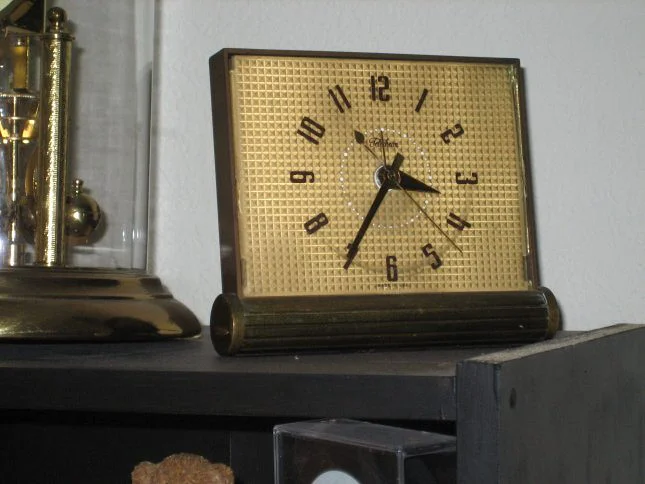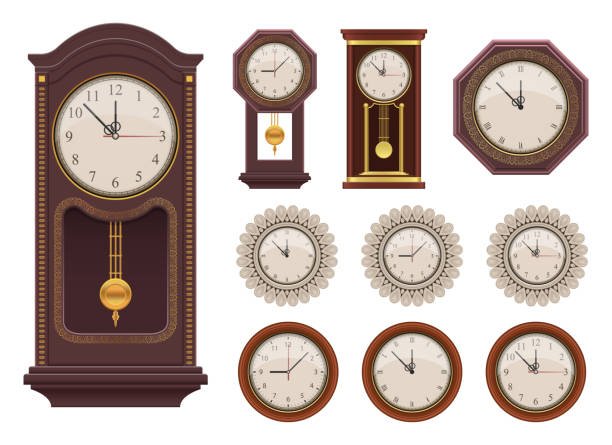Historical Background
Early Influences
Introduction to Japan: Japanese wall clocks emerged during the Edo period (1603-1868), influenced by European and Chinese timekeeping technologies. The integration of these influences led to the development of uniquely Japanese designs.
Cultural Integration: Over time, Japanese clockmakers adapted foreign designs to align with local tastes and aesthetics, resulting in a fusion of functionality and artistry.
Design Elements
Traditional Aesthetics
Intricate Carvings: Japanese wall clocks often feature detailed carvings and decorative motifs. These elements reflect traditional Japanese art, including floral patterns, geometric designs, and cultural symbols.
Lacquer Work: Many Japanese wall clocks are adorned with lacquered finishes. This technique not only enhances the clock’s appearance but also adds durability and protection against environmental factors.
Modern Innovations
Minimalist Design: Contemporary Japanese wall clocks may embrace minimalist design principles. These clocks often feature clean lines, simple shapes, and a focus on functionality, reflecting modern Japanese design aesthetics.
Advanced Technology: Modern Japanese wall clocks incorporate advanced technology, including quartz movements and digital displays. Despite technological advancements, these clocks maintain the high standards of craftsmanship seen in traditional designs.
Materials Used
High-Quality Wood
Types of Wood: Traditional Japanese wall clocks are often crafted from high-quality woods such as cherry, walnut, or maple. These woods are chosen for their durability, grain patterns, and aesthetic appeal.
Crafting Techniques: Wood is meticulously shaped, carved, and finished to achieve a polished and refined look. The woodwork enhances the clock’s overall design and longevity.
Brass and Metal Components
Precision Engineering: Brass and other metals are used in the internal mechanisms of Japanese wall clocks. These components are engineered for precision and durability, ensuring accurate timekeeping.
Decorative Elements: Metal parts may also feature decorative elements, such as engraved patterns or polished finishes, contributing to the clock’s visual appeal.
Production Techniques
Traditional Craftsmanship
Handcrafting: Many Japanese wall clocks are handcrafted by skilled artisans. This meticulous process involves carving, assembling, and finishing each component by hand, ensuring high-quality results.
Assembly: Traditional clockmaking techniques require precise assembly of intricate parts. Artisans carefully align gears, movements, and other components to ensure smooth and accurate operation.
Modern Manufacturing
Advanced Machinery: While traditional methods are still valued, modern manufacturing techniques have been integrated into the production of Japanese wall clocks. Advanced machinery aids in precision cutting, assembly, and finishing.
Quality Control: Stringent quality control measures are employed to maintain high standards. Each clock undergoes thorough testing to ensure accuracy and reliability before it reaches the market.
Notable Japanese Wall Clocks
Classic Designs
Kakei Clocks: Kakei wall clocks are known for their elegant design and pendulum mechanisms. They often feature traditional Japanese motifs and intricate craftsmanship.
Tokei Clocks: The term “tokei” encompasses various types of Japanese clocks, including wall-mounted styles. These clocks reflect a range of designs from historical to contemporary.
Modern Creations
Minimalist Clocks: Modern Japanese wall clocks often embrace minimalist aesthetics, focusing on simplicity and functionality while maintaining high craftsmanship standards.
Innovative Designs: Recent innovations in Japanese wall clocks include integration with smart technology, such as syncing with mobile devices and incorporating advanced timekeeping features.

Preservation and Care
Regular Maintenance
Cleaning: Regularly dust the clock to keep it free from dirt and debris. Use a soft cloth to gently clean the clock’s surface.
Servicing: For mechanical clocks, periodic servicing by a professional is recommended to ensure proper function and longevity.
Proper Handling
Avoiding Sunlight: Keep the clock out of direct sunlight to prevent fading or damage to the finishes.
Temperature Control: Maintain a stable environment with moderate temperature and humidity to protect the clock’s materials and mechanisms.
Conclusion
The craftsmanship of Japanese wall clocks combines traditional techniques with modern innovations, resulting in timepieces that are both functional and beautiful. From intricate carvings and lacquer work to advanced mechanical and digital technologies, Japanese wall clocks reflect a deep appreciation for artistry and precision. Understanding the craftsmanship behind these clocks enhances appreciation for their historical significance and enduring appeal.




Mit einer gültigen Glücksspiel-Lizenz und modernsten Sicherheitsstandards bietet das Casino höchste Seriosität und
Schutz für alle Mitglieder. Wir verwenden auf unseren Seiten Affiliate-Links
und erhalten möglicherweise eine Provision für Kunden,
die an Online Casinos verwiesen werden. Casino.guru sieht sich als eine unabhängige Informationsplattform über Online Casinos und Online Casinospiele, die von keinem Glücksspielanbieter oder irgendeiner
anderen Instanz kontrolliert wird. Teilen Sie Ihre Meinung mit oder erhalten Sie Antworten auf Ihre Fragen.
Durchsuchen Sie alle von Casino Barcelona angebotenen Boni,
einschließlich jener Bonusangebote, bei denen Sie keine Einzahlung vornehmen müssen, und durchstöbern Sie auch alle Willkommensboni,
die Sie bei Ihrer ersten Einzahlung erhalten werden.
Das geht entweder im oberen Bereich mit den Spielautomaten oder unten im großen Spiel,
wo es auch eine Leinwand gibt, um die Spiele live verfolgen zu können. Der Omaha Tisch war zum Zeitpunkt meines Besuchs auch
geöffnet und es wurde gespielt. Es waren insgesamt sechs Tische geöffnet mit Limits 1/2,
2/4 und 3/6. Zum Zeitpunkt meines Besuchs waren ingesamt 10
(!) Black Jack Tische geöffnet. Es gibt keinen Raucherbereich
und auch keine Raucherboxen.
Für die Pokerspieler mit dem entsprechenden Geldbeutel, oder alle die bei den PSO gut gecasht
haben, folgen die großen EPT Majors im Anschluss. Das Jahreshighlight der PokerStars Live Turnierserie wird nicht nur die Massen der ambitionierten Pokerspieler, sondern auch Massen an Preisgeldern bewegen. Der
Automatensaal bietet eine große Auswahl an Spielautomaten, die täglich ab 10 Uhr geöffnet sind.
Das Spielangebot im Casino Barcelona ist vielfältig und spricht sowohl
Gelegenheitsspieler als auch erfahrene Spieler an. Der Flughafen bietet tägliche Flugverbindungen mit den meisten internationalen Metropolen.
References:
https://online-spielhallen.de/ihr-ultimativer-leitfaden-fur-druckgluck-casino-promo-codes/
✅ Advertising restrictions to prevent targeting vulnerable players Choose a trusted
casino from our lists, play responsibly, and enjoy.
Now you know how to sign up, deposit, play, and cash out.
Enter your deposit amount (check the casino’s minimum deposit).
Some casinos may ask for identity verification upfront, while others only require it when withdrawing winnings.
Skrill is a widely used e-wallet, but in Australia,
it’s primarily accessible for casino payments through Utorg,
a third-party processor.
With trusted offshore licensing and a clear focus on Aussie-friendly features, the newest Australian online casinos are well worth exploring.
Whether it’s a slick native app or a responsive browser version, new casinos for Australian players are making
it easier than ever to spin, bet, and withdraw on the go.
Some new casinos in Australia offer provably fair games, which run on blockchain technology and allow you to verify results.
This is another classic that gets a makeover at new
online casinos in Australia.
References:
https://blackcoin.co/high-limit-slots-play-25-100-500-slot-machines-online/
Having registered on an online gambling website, a future player creates his/her personal user account.
You can always find more Australian casino bonuses with us.
To get a no deposit bonus and start playing it is enough to go through
a quick registration procedure, as well as confirm it via email or phone number.
A player cannot withdraw “free” money from the account as long as the bonus is
not fully wagered as per its wagering requirements.
After activating this bonus, there are other deposit offers that Uptown Pokies has reserved
for new punters. First-time players who use the “20FREE”
promo code when creating new accounts at Ozwin Casino get a welcome reward.
Although the casino is less spacious compared to some of the other venues in Queensland, it still
has a lot to offer. Besides, you can take part in tournaments that a casino regularly runs.
You can spend several days in a casino in Queensland and
book cozy accommodation at an earthy price. A good thing about Treasury Casino and Hotel is that it is a
perfect place for gambling travelers. The taxes levied on gambling operators depend on the
state where the gambling company operates.
Check out the best casino options and find a whole
lot of other possibilities to deposit and withdraw.
Some casinos still eagerly accept payments via other methods like PayPal,
you only need to find such a provider. Maybe, you will be able to find an online casino that accepts PaypPal in Australia but we think
it is not worth the effort. There used to be so many
of them, and now barely any gambling website has it among its payment or withdrawal options.
References:
https://blackcoin.co/mind-boggling-facts-you-didnt-know-about-online-casino-gaming/
paypal casinos online that accept
References:
https://macrorecruitment.com.au
online casino roulette paypal
References:
http://woorisusan.kr/bbs/board.php?bo_table=free&wr_id=207516